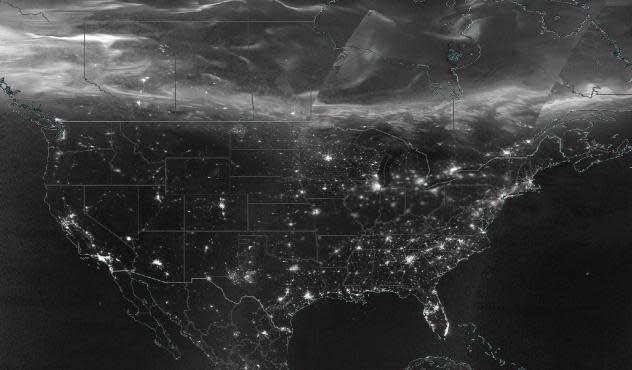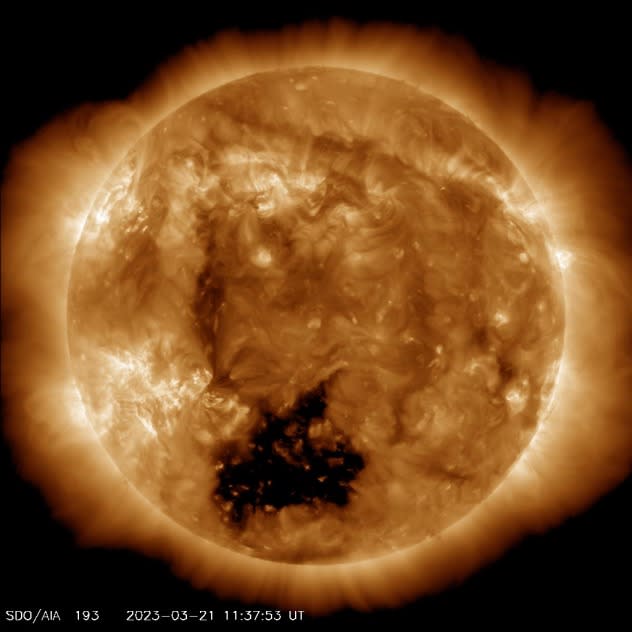Epic aurora danced over US, creating stunning light show
The sun has been in turmoil as of late with frequent solar flares, a twister more than 14 times the size of the Earth and eruptions that have hurled massive clouds of stellar particles through the solar system.
On Thursday night and early Friday morning, the ingredients came together to produce an outburst of northern lights over Canada and the northern half of the United States that stunned stargazers and even left a memorable impression on photographers who often capture pictures of the awe-inspiring aurora.
"I just can't! These overhead Coronas were so beautiful!! Lots of dancing and screaming," aurora chaster Tree Tanner posted on Twitter early Friday morning after capturing mesmerizing images of the lights over Canada.
Incredible displays were also seen across the United Kingdom and northern Europe.
 |
The aurora borealis, also known as the northern lights, glow on the horizon at St Mary's Lighthouse in Whitley Bay on the North East coast in the United Kingdom. Picture date: Thursday March 23, 2023. Photo credit should read: Owen Humphreys/PA Wire (Photo by Owen Humphreys/PA Images via Getty Images) |
GET THE FREE ACCUWEATHER APP
•Have the app? Unlock AccuWeather Alerts™ with Premium+
Photographers who had cloud-free conditions on Thursday night captured breathtaking images of the aurora from coast to coast. Unfortunately, cloudy conditions, rain and severe thunderstorms obscured the light show from the mid-Atlantic to parts of the southern Plains.
Photographers as far south as North Carolina and Oklahoma managed to snap pictures of the aurora borealis.
From last night's incredible display of the #NorthernLights in Montana. #AuroraBorealis pic.twitter.com/UCdjMh5Szm
— Cory Mottice (@EverythingWX) March 24, 2023
A nighttime satellite image captured the view of the aurora from space on Thursday night and early Friday morning. A stripe of glowing celestial lights could be seen draped across southern Canada and the far northern United States. Specks of light dotting the continent are lights from major cities.
 |
A nighttime satellite image showing the aurora glowing over North America on March 23, 2023. (NASA Worldview) |
The origins of Thursday night's light show can be traced to a large coronal hole on the surface of the sun. Coronal holes are common features that spew streams of fast-moving particles through the solar system. When these particles hit Earth's magnetic field, it produces the phenomenon we know as aurora.
The coronal hole did not act alone. It combined its forces with a coronal mass ejection, another cloud of stellar particles that the sun blasted into space.
Here's the view from our office! The auroras are currently overhead here in Glasgow 😍 #MTwx #auroras pic.twitter.com/SCvHOrYPy0
— NWS Glasgow (@NWSGlasgow) March 24, 2023
NOAA's Space Weather Prediction Center (SWPC) said that the solar storm was severe, peaking at a G4, the second-highest category for solar storms. In addition to creating amazing displays of the aurora, solar storms of this magnitude can cause fluctuations with the power grids on Earth, disrupt satellites orbiting the Earth and interfere with GPS. It was also the strongest solar storm since September 2017.
The worst of the storm has passed, but solar unrest is likely to continue into the first part of the weekend across Canada and the far northern U.S.
 |
An image of the sun from March 21, 2023. The darkened area is a coronal hole that was partially responsible for an outburst of northern lights on March 23, 2023. (NASA/SDO) |
The timing of the aurora outburst was perfect for scientists in Sweden who launched a rocket to study the northern lights.
The experiment is part of research to help scientists better understand short-term aurora forecasts and to determine how solar storms can impact satellites in space and infrastructure on Earth.
Want next-level safety, ad-free? Unlock advanced, hyperlocal severe weather alerts when you subscribe to Premium+ on the AccuWeather app. AccuWeather Alerts™ are prompted by our expert meteorologists who monitor and analyze dangerous weather risks 24/7 to keep you and your family safer.




